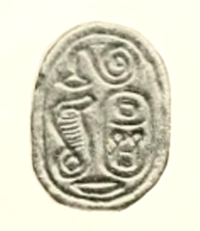
Merneferre Ay was an ancient Egyptian pharaoh of the mid 13th Dynasty. The longest reigning pharaoh of the 13th Dynasty, he ruled a likely fragmented Egypt for over 23 years in the early to mid 17th century BC. A pyramidion bearing his name shows that he possibly completed a pyramid, probably located in the necropolis of Memphis.

Amenhotep III, also known as Amenhotep the Magnificent or Amenhotep the Great and Hellenized as Amenophis III, was the ninth pharaoh of the Eighteenth Dynasty. According to different authors, he ruled Egypt from June 1386 to 1349 BC, or from June 1388 BC to December 1351 BC/1350 BC, after his father Thutmose IV died. Amenhotep was Thutmose's son by a minor wife, Mutemwiya.

Wahibre Ibiau was an ancient Egyptian pharaoh of the 13th Dynasty, who reigned c. 1670 BC for 10 years 8 months and 29 days according to the Turin King List.
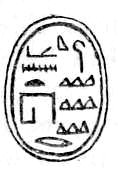
Anat-her may have been the first ruler of the Sixteenth Dynasty of Egypt, reigning over some part of Lower Egypt during the Second Intermediate Period as a vassal of the Hyksos kings of the 15th Dynasty. This is contested however, with the Egyptologists Kim Ryholt and Darrel Baker believing that 'Anat-Har was a Canaanite chieftain contemporary with the powerful 12th Dynasty. Others such as Nicholas Geoffrey Lempriere Hammond contend that he was a prince of the 15th Dynasty. 'Anat-Har's name means "Anat is content" and refers to the Semitic goddess Anat, showing that he was of Canaanite descent.

Semqen was a Hyksos ruler of Lower Egypt during the Second Intermediate Period in the mid-17th century BC. According to Jürgen von Beckerath he was the third king of the 16th Dynasty and a vassal of the Hyksos kings of the 15th Dynasty. This opinion was shared by William C. Hayes and Wolfgang Helck but recently rejected by Kim Ryholt. In his 1997 study of the Second Intermediate Period, Ryholt argues that the kings of the 16th Dynasty ruled an independent Theban realm c. 1650–1580 BC. Consequently, Ryholt sees Semqen as an early Hyksos king of the 15th Dynasty, perhaps its first ruler. This analysis has convinced some Egyptologists, such as Darrell Baker and Janine Bourriau, but not others including Stephen Quirke.
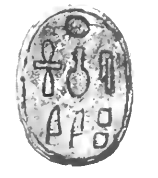
Seneferankhre Pepi III may have been a pharaoh of the 16th Dynasty during the Second Intermediate Period. According to Wolfgang Helck he was the fifth pharaoh of the dynasty. Alternatively, according to Jürgen von Beckerath, he was the thirteenth pharaoh of the dynasty. Because his position in the 16th Dynasty is highly uncertain, it is not clear who were his predecessor and successor.
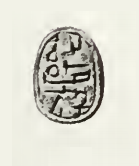
'Ammu Aahotepre was a pharaoh of the 14th Dynasty who ruled over parts of Egypt during the Second Intermediate Period. His reign is believed to have lasted about 15 years, from 1760 BC until 1745 BC.

Maaibre Sheshi was a ruler of areas of Egypt during the Second Intermediate Period. The dynasty, chronological position, duration and extent of his reign are uncertain and subject to ongoing debate. The difficulty of identification is mirrored by problems in determining events from the end of the Middle Kingdom to the arrival of the Hyksos in Egypt. Nonetheless, Sheshi is, in terms of the number of artifacts attributed to him, the best-attested king of the period spanning the end of the Middle Kingdom and the Second Intermediate period; roughly from c. 1800 BC until 1550 BC. Hundreds of scaraboid seals bearing his name have been found throughout the Levant, Egypt, Nubia, and as far away as Carthage, where some were still in use 1,500 years after his death.

Sobekhotep III was an Egyptian king of the mid Thirteenth Dynasty of Egypt who reigned three to four years.

Neferkamin may have been an Eighth Dynasty pharaoh of ancient Egypt during the First Intermediate Period.

Nikare was an ancient Egyptian pharaoh of the Eighth Dynasty during the early First Intermediate Period, at a time when Egypt was possibly divided between several polities. According to the Egyptologists Kim Ryholt, Jürgen von Beckerath and Darrell Baker he was the ninth king of the Eighth Dynasty. As such, Nikare's seat of power would have been Memphis.

Scarabs are amulets and impression seals shaped according to the eponymous beetles, which were widely popular throughout ancient Egypt. They survive in large numbers today, and through their inscriptions and typology, these artifacts prove to be an important source of information for archaeologists and historians of ancient Egypt, representing a significant body of its art.

During the reign of the ancient Egyptian pharaoh Amenhotep III hundreds of so-called memorial scarabs were issued to commemorate the deeds of the pharaoh. Such scarabs were found in several archaeological sites of the Near East, from Syria to Sudan. Over two hundred of them are known to exist in museums and collections around the world.
This page list topics related to ancient Egypt.

Djedankhre Montemsaf was a Theban king of the 16th Dynasty based in Upper Egypt during the Second Intermediate Period c. 1590 BC. As such, he would have ruled concurrently with the 15th Dynasty, which controlled Lower and Middle Egypt.
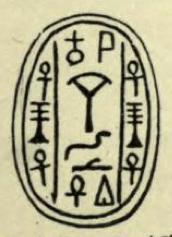
Wazad was an Egyptian pharaoh during the Second Intermediate Period. According to the Egyptologists Kim Ryholt and Darrell Baker, Wazad was a member of the 14th Dynasty of Egypt reigning c. 1700 BC. As a king of the 14th Dynasty, he would have reigned from Avaris over the eastern Nile Delta and possibly over the western Delta as well. The Memphis-based 13th Dynasty reigned over Middle and Upper Egypt at the same time. Alternatively, according to Jürgen von Beckerath and Wolfgang Helck, Wazad was a ruler of the 16th Dynasty and a vassal of the Hyksos 15th Dynasty. This view is debated in Egyptology, in particular because Ryholt and others have argued that the 16th Dynasty was an independent Theban kingdom rather than a vassal dynasty of the Hyksos.

Sekhemrekhutawy Khabaw was an Egyptian pharaoh of the early 13th Dynasty during the Second Intermediate Period.

Sewahenre Senebmiu is a poorly attested Egyptian pharaoh during the Second Intermediate Period, thought to belong to the late 13th Dynasty.
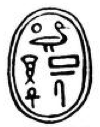
Sheneh was a ruler of some part of Egypt during the Second Intermediate Period, possibly during the 17th century BC, and likely belonging to the 14th Dynasty. As such he would have ruled from Avaris over the eastern Nile Delta and possibly over the Western Delta as well. His chronological position and identity are unclear.
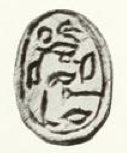
Yakareb may have been a ruler of some part of Egypt during the Second Intermediate Period, possibly during the 17th century BC, and likely belonging to the Fourteenth Dynasty. As such he would have ruled from Avaris over the eastern Nile Delta and possibly over the Western Delta as well. His chronological position and identity are unclear.
